As hard as it is to believe that there are more vintage recordings of Tristan coming to light, it’s even harder to believe that anyone would need a review of one. But I played this when I got it: getting the chance to hear Nilsson and Windgassen when they were young–she 40 and he 44–rather than the usual 10 years later that we hear on other recordings proved irresistible. And for the two of them this set is well worth it, even if you own others.
Sawallisch leads a brisk performance–3:50–much like Kleiber, far less than Solti I or Bernstein (4:26), or Goodall or Runnicles, and just 12 minutes more than Böhm. But particularly in the first two acts, he allows the full sweep of the work to be chopped up by individual moments/scenes from the soloists. Granted, if I had singers like Nilsson and Windgassen in 1958, I might be tempted to just listen, but the overall effect is that of a grand set of excerpts.
There are remarkable moments to be sure: after a far too matter-of-fact first hour of Act 1, the confused hysteria of T and I after they’ve drunk the potion is wildly exciting, deep, and resonant. Similarly the lovers’ meeting in Act 2 is nearing ecstatic panic, but it’s more like two very healthy young horses finally have been let out of the paddock. The love duet does not glow or shimmer, it just unfolds nicely, with a good buildup to the interruption. Sawallisch redeems himself in the last act with a darkly yearning Prelude, sweetly sad opening phrases, and shocking mania from the orchestra, while Tristan follows through to a transformative Liebestod.
Nilsson is breathtaking, as usual. She may not have quite the same sneering disdain that she musters for Böhm at Bayreuth, or the same soft melt–in fact the middle of her voice here can occasionally lack clarity. But she’s still in a class by herself and never lets her concentration flag. I might say that this is Windgassen’s greatest recorded performance if I wished to start a discussion, but I can say for sure that his voice has a greater, more solid “core” here, and that he never tires. His last act is on a par emotionally with Vickers’ genuinely alarming performances.
Grace Hoffmann and Erik Saeden are a pair of young, vibrant-sounding servants: her mezzo is a bit too Nilsson-like-soprano; occasionally when their lines nearly overlap one might get confused. Saeden’s Kurwenal is gentle but burly. I fear that Josef Greindl’s Marke, though well-wrought and moving in his monologue, sounds wooly and a bit wobbly–it’s just not very nice to hear. Fritz Uhl, the much maligned Tristan of the Solti I performance, is here a fine Melot. Joself Traxel’s clear, clean Steersman is a joy to listen to.
The sound is remarkably good for 1958, and of course the Bayreuth forces play ideally. Final word: Sawallisch’s lack of an over-riding identification takes this out of the front-runner category, but Windgassen and Nilsson are simply great.
































